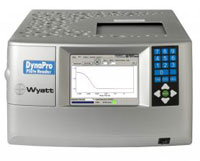Determination of Molecular or Particle Size Services

Wyatt technology’s DynaPro Plate Reader II instrument allows for high-throughput data collection of Dynamic Light Scattering (DLS, a.k.a. Quasi-elastic Light Scattering) data which can be used to determine the hydrodynamic radius (size) and size distribution of polymers and biopolymers in solution.
-
Determine the hydrodynamic radius (Rh) and sample polydispersity (Survey multiple buffer conditions to find the buffer that gives the lowest %polydispersity)
-
Determine the Critical Micelle Concentration (CMC) of surfactants under a variety of sample conditions (pH, temp, etc.)
-
Plate reader accepts 96, 384, 1536-well glass bottom plates with approximate minimum sample volumes of 100, 50, and 5 µL respectively (Average read time for a full 384-well plate is <1 hour)
-
Temperature controlled operation allows for the determination of polydispersity, size, and thermal stability between the range of 4- 85°C
-
Onboard camera allows user to capture images of each well so images can be inspected for precipitant, bubbles, etc., which can lead to poor results
-
The latest DYNAMICS software is available to collect, display, and analyze your data
The minimum concentration of the material under investigation depends on the molecular weight, the larger the polymer the lower the conc. that can be sampled. Using lysozyme (14 kDa) as an example a sample conc. as low as 0.125 mg/mL can be used whereas a protein with a molecular weight of ˜120 kDa could be used at a conc. of 0.015 mg/mL. We recommend starting with 0.5 - 1 mg/mL and trying multiple concentrations. The volume of sample needed depends on the plate used (see above) and the number of wells used (duplicate samples are recommended). Dr. Jenkins is available to help new users on the design, implementation, and analysis of DLS data on a fee-per-service basis.